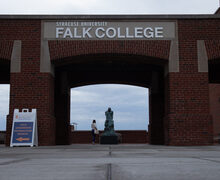Learning curve: Kavajecz explains grading policy changes
When Ken Kavajecz became the dean of the Martin J. Whitman School of Management in April, he wasted no time addressing what he said he saw as inconsistencies in the school’s curriculum.
He noticed grading distributions of some courses were irregular at best. He discovered some classes giving one hundred percent A’s and felt this needed to change.
“In my mind, that doesn’t fit with reality,” Kavajecz said.
Whitman implemented a new grading system at the start of the spring semester in order to counter any discrepancies in curriculum while also increasing the rigor of courses, Kavajecz said.
The new grading system applies to all Whitman undergraduate courses, excluding honors classes and internships taken for credit. The system creates a curve in which, at most, only the top 33 percent of the class will receive A’s, creating a class average around a B or B-plus.
The system was created in the summer of 2013, discussed in the fall, and then unanimously voted on and passed. Whitman faculty members creating the system looked at similarly curved grading models such as the one used by Princeton University’s business school.
Angus Heaton, an undeclared freshman in Whitman, said he found out about the policy changes when announcements were made in class during service week.
“It’s still kind of in the early stages, but the general idea among students I’ve talked to is that it’s annoying. Reactions haven’t been particularly positive,” Heaton said.
Heaton believes negative student reactions stem from students being concerned for their personal grades rather than the reputation of the school, he said.
Heaton said he feels the system may not particularly serve the best interests of students, but was instead created to impress potential employers and advance the reputation of the school. Within the last year, the Whitman school increased 6 spots — from No. 61 to No. 55, but two years before, the ranking fell 14 spots – from No. 47 to No. 61.
Now that the policies have been implemented, Heaton said he feels some pressure to work harder for his grades.
“As a freshman, I may have to put in more work in the next three years than students who are graduating this year,” Heaton said. “But in that sense, you could say it will create more hardworking students.”
Megan Clark, a senior marketing major, said she feels upperclassmen have reacted more positively to the changes.
“I think in general, from a senior perspective, a lot of students were mad at first. But then, when you think about it, I want to be able to say that I’m a Whitman alumni and have that mean something. This will make that more credible,” Clark said.
She said that her professors explained the new system on the first day of the spring semester. Clark said she felt that the professors had generally positive outlooks toward the system, and thought that it would challenge Whitman students and give more credibility to the school.
“I do think the new system gives more values to A’s,” Clark said. “Going into interviews and saying that I graduated with a 4.0 is more impressive now that it means I’m in the top 33 percent.”
Clark said that since the system change at the beginning of the semester, she has increased her in-class participation in order to adjust to the curve.
“It’s in the back of my head during class. I’ve stepped up my participation because I think that extra ten to 15 participation percentage of our grade could be the cut off line for the top 33 percent,” Clark said.
Clark said that she thinks the grading system may work better in some courses than others. In certain courses, such as math courses, it’s a right or wrong answer, Clark said. In this case, the grading can be so numeric that it can be very difficult for students to set themselves apart or balance their grade, Clark said.
“I don’t know if it was completely thought out course by course,” Clark said. “I think they could have used some more student perspective, and there may need to be some curricular adjusting.”
Dean Kavajecz said he is aware that students have shown mixed reactions.
“The purpose of the policies is to protect, engage and challenge students. It seems to me that it’s often being perceived as the opposite,” he said.
Kavajecz said that his priority as dean and the purpose of the new policies are to create a better experience for students, not to enhance the rankings of the school.
“My focus is to ensure that we are rigorous, coordinated and deliberate in our approach so that all students get the same experience when walking through our hallways. That is my priority and that is my focus. If we can accomplish this, rankings will follow,” he said.
Kavajecz said that he has heard some positive reactions from students and parents, and he hopes that as the changes settle in, more positive reactions will follow.
Said Kavajecz: “As it relates to policy, people need to know this isn’t about splitting hairs over who gets an A and who gets a B. This is about preparing students well, and making courses challenging and rigorous.”
Published on February 11, 2014 at 1:28 am
Contact Lydia: [email protected]




